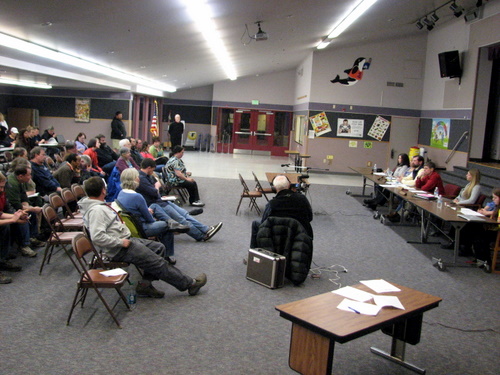
About fifty Sitkans attended the board’s final budget hearing Monday night. (KCAW photo/Robert Woolsey)
The Sitka School board cut no staff when it met this week (4-22-13) to approve its final budget for next year, but it did eliminate what many consider a critical position at the high school.
The board is also counting on support from the Assembly to tie up the last loose ends of the district’s finances.
Listen to iFriendly audio.
The budget the school board will deliver to the assembly is not balanced. There’s still a shortfall of about $68,000, out of a total of $19.6-million. That’s pretty good news considering the board went into the meeting over $300,000 in the hole, with at least six jobs on the line.
Board president Lon Garrison made it plain, however, that the Sitka Schools were growing too comfortable living on the edge.
“We have been the benefactors of very good luck for many years. I know you’ve heard us say this many times, and we always seem to come out on the other side in some way, shape, or form. We’ve been here before, and we’ve had some things in the works, and we’ve been able to get through by the skin of our teeth, and end up saving everything that we have, and be able to have some money left in our reserves. And I think the days of that happening could be gone.”
The budget gap was closed — in large part — through an eleventh-hour appropriation by the state legislature for school security. It was a reaction to the shootings last December at Sandy Hook Elementary School in Newtown, Connecticut. School districts in Alaska with less than 4,500 students — like Sitka — can use their share of the funding for energy costs.
Sitka Schools will receive one-time funding of about $245,000.
The other budget-closing measure was the long-expected decision to eliminate the Activities Director position at Sitka High School, for a savings of about $90,000.
About fifty Sitkans attended the hearing. Eighteen testified before the board, many speaking on behalf of preserving the three jobs at the top of the list of proposed cuts: the high school activities director, the Community Schools swimming pool manager and sports coordinator.
No one on the board wanted to cut staff. The debate was really about principle: What is the role of Community Schools now, and does it make sense for it to absorb the duties of organizing high school activities?
Board member Tim Fulton thought re-assigning high school activities to Community Schools was missing the point.
“If we want to cut the activities director, I think we need to start thinking about cutting activities.”
But, Fulton said, it was also clear to him that residents didn’t favor cutting activities.
Barb Morse ran Community Schools for ten years. She reminded the board that although the organization operates under the district’s budget, it was never intended as an adjunct of the schools. She said it was created to benefit the city.
“The Parks and Rec Department doesn’t do recreational programming. So it was the understanding that the funding was used for that purpose. That’s why I was astonished that since 2000 it had slipped back the other way, and it was no longer designated for Community Schools to do community recreation. I would really urge you to consider the intent of Community Schools, and why the city funds it.”
Several board members, at the urging of superintendent Steve Bradshaw, nevertheless wanted to try merging the duties of high school activities director with those of Community Schools’ sports coordinator — a job held for the last twenty-four years by Woody Widmark — and with the duties of Community Schools director Scott McAdams.
McAdams thinks it might be a step in the right direction.
“It’s almost like we’re going back and doing a course correction to our core mission.”
McAdams observed that Community Schools had evolved considerably since its creation, and was far more than the after-hours manager of school buildings. It runs the Ventures program at Baranof Elementary, community recycling, a tobacco cessation program, and several other grant-funded projects to name just a few. His implication was that Community Schools had drifted from its original purpose. And though absorbing high school activities might work out, he didn’t think getting there would be easy.
“Will we be able to also find the time and capacity to be able to also run a high-quality high school sports program, in addition to our core mission of community schools? It’s going to be a big job, no question about it. If I speak in support of this, I’m telling you I support increasing my day from 8 hours to 12 — maybe 14. So certainly, that’s a ramping-up of my duties.”
Board member Tim Fulton opposed eliminating the high school activities director position, as did student member Jesse Bartelds. Mike Vieira, who currently holds the job, will transfer into the classroom beginning next year and teach high school wood shop.
The board easily dropped $16,000 allocated for a service that phones substitute teachers. After that, board member Jennifer Robinson moved to forward the budget to the assembly with no further cuts, though it was $68,000 shy of balancing.
She said there was a strong likelihood that federal Secure Rural Schools funding would bridge that gap and — in that event — the district could repay the assembly, as it has done in the past.































